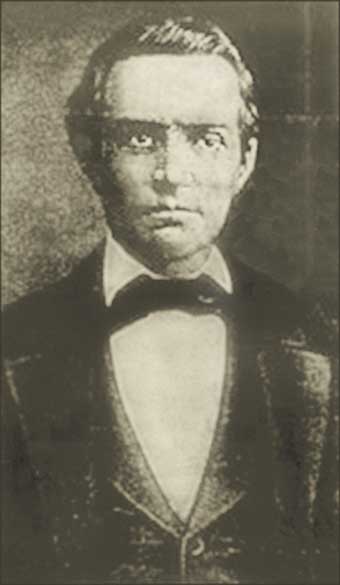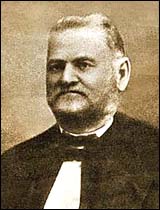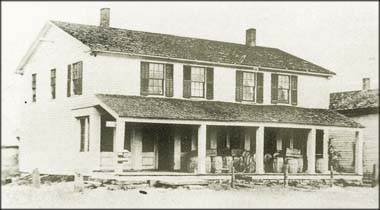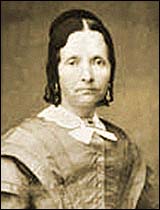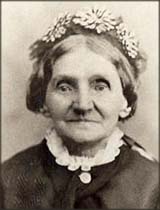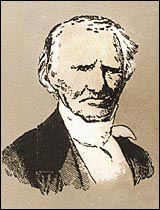When Did SIDNEY RIGDON
First Meet JOSEPH SMITH?
Reminiscences of
Darwin Atwater
|
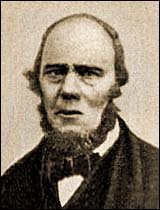
|
1873 Darwin Atwater statement
Amos S. Hayden's Early History of the Disciples in the Western Reserve
(Cincinnati: Chase & Hall, 1875, pg. 239)
view the transcriber's notes on this subject
MANTUA STATION, April 26, 1873.
DEAR BRO. A. S. HAYDEN:
The infant church at Mantua was left small and inexperienced. I was the only one who had been accustomed to take an
active public part. There were Bro. Seth Sanford, and Bro. Seth Harmon, both very young in the Christian profession,
with a number of excellent sisters. In our weak state, in the midst of so much opposition, we were poorly prepared
to take care of the church. March 21, 1830, I was ordained elder, (in my youth), and Bro. Seth Harmon was ordained
deacon -- Adamson Bentley officiating.
At this time, Oliver Snow, an old member of the Baptist church, united with us. His talents, age and experience, ought
to have been very useful to us, but they were more frequently exercised in finding fault with what we attempted to do,
than in assisting us. This only increased our embarrassment. Soon after this, the great Mormon defection came on us.
Sidney Rigdon preached for us, and notwithstanding his extravagantly wild freaks, he was held in high repute by many.
For a few months before his professed conversion to Mormonism, it was noticed that his wild, extravagant propensities
had been more marked. That he knew before of the coming of the book of Mormon is to me certain, from
what he said the first of his visits at my father's, some years before. He gave a wonderful description of the
mounds and other antiquities found in some parts of America, and said that they must have been made by the
Aborigines. He said there was a book to be published containing an account of those things. He spoke of
these in his eloquent, enthusiastic style, as being a thing most extraordinary. Though a youth then, I
took him to task for expending so much enthusiasm on such a subject, instead of things of the gospel. In all my
intercourse with him afterward he never spoke of antiquities, or of the wonderful book that should give account of them,
till the book of Mormon really was published. He must have thought I was not the man to reveal that to.
In the admiration of Sidney Rigdon, Oliver Snow and his family shared very largely; so, when he came with his pretended
humility, to lay all at the feet of Mormonism, it caused a great shock to the little church at Mantua. The force of this
shock was like an earthquake, when Symonds Ryder, Ezra Booth and many others, submitted to the "New
Dispensation."
Eliza Snow, afterward so noted as the "Poetess" among the Mormons, led the way. Her parents and sister, and
three or four other members of the church, were finally carried away. Two of these were afterward restored.
From this shock the church slowly recovered. Bro. Ryder returned and exposed Mormonism in its true light. The Mormon
character soon exposed itself.
Marcus Bosworth continued to preach for us. Symonds Ryder soon resumed his public labors with us, and regained the
confidence of the community.
In the year 1834, there were several additions to the church. Its growth has never been rapid. We never had very large
accessions, or very low depressions.
In 1839, we built a meeting-house at the center of Mantua, and commenced to occupy it late in the Fall. It was soon
after this that you labored for us. About this time, (January 19, 1840), John Allerton and wife, from the church at
Euclid, and Selah Shirtliff and wife united, from the church in Shalersville -- all the same day. Of the events during
your labors for the church at Mantua, in 1840 and 1841, I need not write.
After much prayerful consideration, the church ordained Selah Shirtliff and John Allerton as elders, and Seth Sanford,
deacon. This was done August 21, 1841. In the above, I should have mentioned that Walter Scott preached for us several
times. Father Thomas Campbell a number of times. Alexander Campbell once, and Bro. Alton once. Jacob Osborne several
times before our organization, and once afterward. Adamson Bentley once or more. John Henry one meeting of days.
William Hayden many times. D. ATWATER.
|
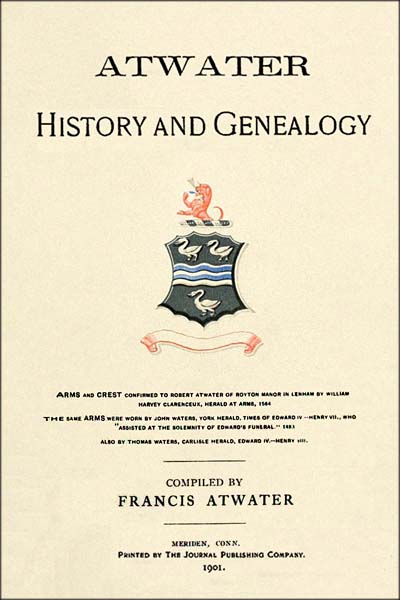
ATWATER HISTORY.
225
Edwin, b. June 13, 1817; m. Harriet Wilmot; she d. in 1877; (2) 1881,
Betsey Pierce. He d. Nov. 22, 1899.
Diantha, b. June 18, 1819; d. in April, 1820.
The ancestral home of the Sanfords was at Milford. Conn., on the Sound, and there Captain Samuel Sanford seems to
have resided part of the time after his honorable service in the Revolutionary War. But before the war he had lived
some years at Harwinton. about forty miles to the north, and there * young Samuel, his oldest son, was born in 1766.
As a boy he had served as his father's attendant in the army. Both Enos Atwater and the elder Sanford were in the
Boston camps in the campaign of 1775, and the latter as lieutenant was in the battle of White Plains, New York,
which proved fatal to Jotham Atwater. The acquaintance between the families may thus have begun in the hardships of
the War for Independence.
Samuel and Rhoda Sanford moved over and settled on a farm in Harwinton, Conn., perhaps twenty miles to the north of
her old home. Rhoda was the more pleased to go there from the fact that her Aunt Mabel Bassett and husband, Levi,
had just gone to live in Harwinton. where they had bought a large farm near the Plymouth line. These families
resided thus as neighbors only a short distance apart for twenty years and more, and Rhoda, we presume, had her
Aunt Mabel to consult with till the Sanfords pulled up stakes, and, at the invitation of Rhoda's brother, Amzi
Atwater, migrated to Ohio. They had nine children at the time, and seven of them were in the company that made the
hard and toilsome trip to the new country in March, 1817. The two older sons did not accompany the family west.
Raymond, at the age of 21, had found satisfactory employment with a business firm. He traveled south and became
a successful Southern planter in Lumpkin County. Georgia, and has left a worthy and numerous posterity. Gerry
remained with his father's brother in Vermont, and three years later started to go to the family in Ohio, but never
arrived, and is believed to have been drowned by falling from a vessel on the lake. The Sanfords paid a man one
hundred dollars to take them in two wagons to Ohio. Judge Atwater, who had lately (1816) built a new house and moved
out of the log structure where he and his bride, Huldah Sheldon, had gone to housekeeping in November, 1801, kindly
received them to the old home till they couid get a start. He had bought, some time before, a hundred acres of land
about two miles to the northeast of his home. Of this tract he sold to his brother-in-law thirty-three acres,
including the site of "Mud Mill" (erected afterward) and the fine high ground where they built on the spot where
the "Dustin House" now stands. Though land was increasing in value, the Judge probably charged him only what he
paid. But Joe Skinner's distillery made the location bad for a residence. Later on, when the boys were grown up,
Seth bought out his father and the family, in March, 1832, moved oyer to the fifty-acre place, where they made
their permanent home. Jason at the same time (1831) buying the hundred acres to the east, Aunt Miriam Pond, or
son Everett, taking some sixty-six acres, and the Wilmots about eighty-three acres of the Granger tract, of lot
40, of 420 acres, sold by Judge Atwater for Mindwell P. Granger at $3 per acre.
Edwin Sanford, in his old age, related to the writer two interesting incidents occurring about the last of their
stay at the "Mud Mill" home. The first was connected with the coming of the Mormons early in the year 1831. He
remembered their bringing their converts to the river near the bridge for baptism, which Edwin, as a boy of fourteen,
witnessed. Previous baptism in an orthodox church did not count with Joe Smith and Sidney Rigdon. (See "The Portrait,"
pages 64 to 69.)
A little later, -- the fall of 1831, -- Edwin's father had the misfortune to fall, while walking with a crowbar
in hand, across the mill-dam. and break his leg. Edwin ran for Dr. Earle, who, with his family, had just returned
from Paxton, Mass., and had moved into the" brick tavern" home with "Aunt Laura." It proved a slow case of healing;
the father was now sixty-five years of age and was never very active afterwards
__________
* But Edwin Sanford said his father was born at Milford.
ATWATER HISTORY.
239
(1900) stands as a dwelling-house, but the initials of its builder, "J. A.," in large letters on its front, as
well as the date, "1825." close under the cornice, have long since disappeared. It was a big job, probably the most
expensive house in the township at the time, and taxed the owner's resources to the utmost. Before it was really
done and furnished daughter Silvia and Dr. Earle were married in it (October 5, 1826) and he went to practice
medicine at Paxton, Mass., near Worcester, where they spent five years. Matilda and Minerva Twaddle, two bright
young ladies, were often in Jotham's family at this time and joined him in letter-writing to the Earles. The former
of these ladies married Albert Pond; the latter, excelling as a teacher and talker, married John Coburn and moved
to DeKalb County, Ind. * While Uncle Jotham was struggling to get the big house paid for he was taken dangerously
sick with internal inflammation. His brother, Amzi, came to watch with him the last night of his life, Nov. 4, 1828.
It was nearly midnight when Amzi gave Jotham "some medicine, which he took as usual," then he turned round to "set
the dishes in their place," and, perceiving him in distress, supported him as well as he could," and "in less than
half a minute he was entirely dead."
The surviving brother wrote Elias Bassett:
"This sudden and unexpected death has left his family in a disagreeable position,
and probably will require some new exertions of mine to settle his embarrassed
estate. He, although possessed of a valuable property, was considerably in debt."
Darwin Atwater was appointed administrator. It was found there was a note of Jotham's to his mother, Lois, for
$100, and a bank debt of nearly $200, and due bills to the amount of nearly $300. If Uncle Jotham could have had
life and health, he would have had his affairs in good shape in a few years. His widow, Aunt Laura, was industrious
and economical. She had the nephews, Edwin Sanford and Everett Pond, work the farm, so they kept along. The Earles
returned with their little son. (?) George, in the fall of 1831, and all lived together for a time, and the doctor
gained a practice in Mantua. Two years later Julia made her unfortunate (?) marriage with the stage contractor,
Simon Stough, and her mother died the next
__________
* Minerva Twaddle wrote to Silvia Earle (April, 1827): "Mr. Rigdon preaches here every fourth Sabbath. Eliza
and Amanda Snow and Parthena Sanford have been baptized, and it is expected that several others will be at the
next meeting." This Eliza Snow was the talented daughter of Oliver Snow, a leading citizen, who lived on his farm
at the Corners, a mile west of Jotham Atwater's brick tavern. She had a brother, Lorenzo. They were, doubtless,
great partisans of the Baptist preacher, Sidney Rigdon, and three years later followed him into Mormonism. Mr. Snow
was baptized by the Mormons in the little stream near home, Eliza leading, and later becoming an additional wife
of Joe Smith, and still later noted as the Mormon poetess, though her father, Oliver, when he came to know Smith
and had lost property by him, pronounced him a fraud and refused to go further. Eliza described in verse the
killing
of her "husband," (?) and she and Lorenzo followed the new leader, Brigham Young, to Salt Lake City. Eliza was her
brother's biographer. Lorenzo became a noted Mormon missionary, traveling over much of Europe as well as his own
country; was long one of the "Apostles," and at last, in 1898, at the age of 84, he has been elected President of
the Mormon Church.
240
ATWATER HISTORY.
year. August 30, 1834, at the age of 47 years. So the united family life came to an end, and Jotham's nephew,
Jason Sanford, then the most active, most energetic and capable young business man for miles around, bought the
real estate, and conducted the hotel until his premature death in 1848. Dr. Earle and family settled in Newton
Falls, Ohio, where he practiced medicine for years.
993. Lois 6 (Enos5, Jacob4, Jonathan3, Jonathan2, David1), b. June 23, 1784; m. Jan. 24, 1805. Samuel Judson,
at Mantua, Ohio. She d. March, 1813. * They lived near the" Mud Mill," perhaps at first west and then east of the
mill. In May, 1812, on the formation of the Congregational Church in Mantua, Lois became a charter member. There
appears to have been fourteen persons who united to make the beginning, according to the history of Portage County.
Alma, b. 1807; m. Enos Ford; lived in Braceville, Ohio. Had three children; d. in 1896. She had small comfort
in old age.
Alvin, m. and lived in Braceville; was present with his Uncle Amzi and Cousin Darwin at the funeral of his cousin,
Sophia Pond Rich, Aug. 15, 1844.
Ella (a son). m. and lived in Indiana.
Elijah, m. and had four children.
Cyrus, "went west."
994. Miriam 6 (Enos5, Jacob4, Jonathan3, Jonathan2, David1), b. Jan. 7, 1788; m. at Mantua, Ohio, Jan. 24. 1805,
David Pond. He d. May 31, 1827. Miriam d. Nov. 14. 1870, at Maynard, Iowa. They lived and he died in Mantua, Ohio.
Mira, b. Nov., 1805; d. in 1828.
Albert, lived at Concord, DeKalb County, Ind. Had one child.
Everett, d. at Lima, Ill., about 1846-7.
Sophia, m. George Rich (a preacher); d. in Auburn after the birth of daughter Mary, Aug. 15, 1844.
Mary M. b. July 22, 1844; m. James Conrad, Oct. 1868. They have one son. now
Dr. A. E. Conrad, Maynard, Iowa.
Allen, d. in Mantua. Ohio, Nov. 30, 1828.
Lois, d. in Illinois or Missouri, June 1, 1839 (or 1840).
Oscar, d. Oct. 16, 1844, of quick consumption, at Lima, Ill.
Linus, b. ___ ; d. Dec. 26, 184, at Lima, Ill.
Newton, returned with his mother from Illinois and Missouri in 1849; went south to New Orleans about 1850.
Never returned.
__________
* Mrs. Sallie Judson Vaughn (Mrs. Truman V.), dau. of Samuel Judson by his second
wife, in interview with the writer, Dec., 1898, mentioned that John Rudolph and
Darwin Atwater came over to their home to nurse and watch with her father in his
last sickness, about the year 1827. She also said she remembered the time (as they
then lived at the foot of the Stevens Hill in Hiram) when Joe Smith was mobbed and
tarred and feathered at the top of the hill, March [1832]
ATWATER HISTORY.
241
No doubt wonder has been expressed many times in the family connection that Aunt Miriam Pond [1788-1870] should have
"gone with the Mormons," especially since Judge [Amzi] Atwater, her older brother and natural advisor (he was the
acknowledged counsellor of his sisters and, indeed of all the Ohio kindred) urged to the contrary,
and her nephew, Darwin Atwater, elder of the newly-formed Disciple Church, of which she was a member since Sept. 16,
1827, steadfastly exhorted the members to stand firm against the Mormon delusion. It must be remembered that several men
of good standing and great influence gave in their adhesion to the new faith. First of all was the preacher, Sidney
Rigdon (who undoubtedly was a fellow-conspirator with Joe Smith, and perhaps the real originator of the fraud),
then there was Oliver Snow, a Baptist since 1809, later in the Disciple Church, a farmer of property and intelligence;
and Rev. Ezra Booth of the Methodist Church,
a bright and well-informed man, whose daughter, Almeda, a score of years later, became a prominent teacher at Hiram and
an associate of President Garfield in that noted school; and last, but not least, Symonds Rider, of Hiram, the young
preacher who had come out to profess his faith when Elder Thomas Campbell (father of Alexander) preached May 25, 1828,
in Jotham Atwater's barn. All these had great weight. Then we must bear in mind that the astonishing account of the
finding by Smith, under the direction of an angel of God, of the box buried in a hill at Manchester, New York,
containing the golden plates of this new dispensation seemed to have strong testimony, since Cowdry, Whitmer, Harris and
others testified that they had seen the plates; that the leaders appeared to speak in other tongues, especially the
Indian dialects, and positively claimed the power to work miracles, and appeared to prove it by Mrs. Johnson, of Hiram,
who showed her arm which had been withered and useless, but at the command of the prophet had been restored "whole as
the other."
"The Portrait," 4 page 64, has this helpful passage:
"It is difficult to comprehend the intense excitement and commotion produced by the tales of these marvels.
Especially were the New Disciple churches shaken by the course of Rigdon; and all the more
so, when it was known that he in no way changed or varied from his old faith and preaching, and that the new
revelation was but a supplement of the old, -- a realization of the pouring out of the spirit in these last days.
[It was also said that the text of the new and marvellous book explicitly sustained the special views and dogmas
of their churches.] Those outside of all church organizations, as well as the members of established
sects, were under a degree of excitement which cannot be appreciated at this remote time."
The people who were being duped could not look behind the scenes, as "The Portrait" enables us to do, and behold the
mask of piety thrown off and rightly see the bare-faced imposition which was being practiced upon the incredulity by a
vulgar deceiver.
"The Portrait," page 78,
after exhibiting Smith as acting before his followers the role of the prophet with some dignity,
presents him behind the scenes:
__________
4 "The Portrait, A Romance of the Cuyahoga Valley," by A. G. Riddle, ex-congressman.
242
ATWATER HISTORY.
"Ha, Sid, old fellow," slapping the still astonished Rigdon on the shoulder, "what so you say to that -- rather goodish,
eh?" "It will do, I think," replied the latter laughing faintly. "But I tell you what," gravely, "that light on the
other side of the creek was rather shallow and won't bear repeating." "Oh, well, it won't be necessary to claim anything
for that if there is anything said about it. Cotton-wicking and turpentine don't cost much. But I was devilish afraid
that Olny would give tongue with his unknown jargon -- 'Shalang, shala, shale, shalo.' God, I'd give something for an
interpreter of that." "Let's have none of that here," said Rigdon decidedly. "Nor will it do to attempt such another
performance in this neighborhood. There are cool, shrewd heads all about us here."
"What's the prospect with the Atwaters and the Snows and Deacon Carman (Harmon)," asked Smith.
"I've some hopes of the Snows; Uncle Oliver is long-headed, but then he is wrong-headed, and we'll catch him in that.
If we do, the family will follow. As for young Atwater, he and the younger Campbell married sisters,
you know." "I'd like to try Alexander himself," said Joe, a little assertively. "You'd wither under his glance
like a plucked pumpkin blossom in August," said Rigdon contemptuously. "His eye is like an eagle's, and he is as form
and clear as rock crystal."
So Aunt Pond and five of the children, Everett, Oscar, Linus and Newton, and daughter Lois, followed the "Prophet." The
story of their hardships, partly told by the letter (now in possession of A. Atwater, Bloomington, Ind.) of Oliver Snow,
from Far West, Mo., Jan., 1839, to his friend Judge Atwater, and partly by the letters of the Pond brothers, is a sad
one... Oscar lived to write of the mob that killed Joe Smith, June, 1844, and Everet lived to know of the election of
the strong and vigorous leader, Brigham Young, and the excommunication of the contumacious Rigdon, and perhaps
of the
departure of the Mormon vanguard for Salt Lake in 1847. Being left penniless and destitute, Aunt Pond was gald to accept
the aid ($50?) of her brother to get back to her Ohio kindred. "Why, Miriam, have you come?" was his expression on
meeting her. Newton, the remaining son, came with his mother, worked about for a short time, went South, and was never
heard of more. Judge Atwater left to Aunt Pond in
__________
* Now in possession of A. Atwater, Bloomington, Ind.
ATWATER HISTORY.
243
his will the provision of an annuity. Her nephew, Darwin Atwater, built a room for her as an addition to his
house, and when she wished to live alone he and her other nephews, Edwin and Seth Sanford, built her a little
cottage on what is now Prospect street, Mantua Station, Ohio. She died at the home of her granddaughter, Mrs.
Mary Rich Conrad of Maynard, Iowa....
246
ATWATER HISTORY.
... One inquiry of Jason [Atwater] (letter to Amzi, 1832) has a strange sound in this remote age. After inquiring
about the Mormons, he wrote,
"I should like to know the truth on this point and also whether the sect called
Campbellites or Rigdonites is increasing."
The strangeness now appears from the fact that Rigdon (who had been a Baptist preacher and had
imbibed some of the views of Alexander Campbell) turned out to be be the real originator of Mormonism, while
no theologian exposed that fraud more strongly than did Mr. Campbell, no body of people more vigorously resisted the
spread of the delusion than his associates.
298
ATWATER HISTORY.
school taught in Mantua (perhaps the first in all that region) for it was held in her father's own log dwelling
house. John Harmon. her mother's young cousin (afterward prominent in the county, then but 17) was her teacher.
When the same young man, two years later, taught in her home, Cleona at six was better able to improve the
opportunity. (See Portage Co. Hist. p. 485.)
THE COMING OF THE SANFORDS.
Cleona was in her fifteenth year (March 28, 1817) when her Aunt Rhoda Sanford, husband and seven children arrived
from Connecticut. Edwin was not born till the following June. They had been on the road four weeks and coming in
covered wagons through March storms and cold and mud. they were about worn out. It was a wonder that they all
lived it through. Cleona was delighted to meet her interesting cousin, Julia Sanford (afterward Mrs. John Haven),
only a few weeks younger than herself, and to have her for a companion, while they lived in the settler's first
cabin near by. As her father and mother practically adopted little Parthena Sanford, then a child of seven years,
she had her help in taking care of baby Matilda and later baby Lucy, while Julia's younger sister, Emeline, went
to live with her Aunt Mary Hine.
THE RUDOLPH FAMILY.
Mrs. Lucretia Rudolph Garfield, widow of the President, in a letter to the author of these notes, date of Dec. 28, 1900,
gives this account of her people:
"The Rudolph family was either Prussian or Austrian (the records are not very definite),
but a Colonel ____ Rudolph come to America about the beginning of the eighteenth... century. He settled in Maryland...
He had two sons, Tobias as Jacob. The latter had several sons, one of whom was my grandfather, John Rudolph. He (John)
left Maryland... and came to Garrettsvile [Ohio] about 1805 or 06... I cannot give the dates of births and marriages
except of my father [Zeb Rudolph]. He was born Feb. 23, 1803, and was married Oct. 7, 1830."
From this statement it appears that John (Junior) was the oldest of the children. He was born in the Shenandoah
Valley probably in 1799 or 1800, as he was six years old when they came to Ohio. The Garretsville above mentioned
was a new settlement in Ohio about 36 miles southeast of Cleveland... This place
was six or seven miles east of Amzi Atwater's farm.
The Rudolph family were members of the Baptist church and helped to organize a church of that faith in the village in
1808. When the Reformation preached by Alexander Campbell spread through northern Ohio
ATWATER HISTORY.
299
twenty years later, nearly or quite all of the Rudolphs and Atwaters and the Baptist churches in the country regions
generally accepted the doctrine.
As the Rudolph and Atwater families attended church together, probably first at Garretsville, certainly later at Mantua,
the young folks became acquainted... they were all members of the Baptist church at Garrettsville up to this time. In
Hayden's "History of the Disciples in the Western Reserve,"
page 237, occurs this passage: "That portion of the members
who maintained the sufficiency of the revealed will of God for all purposes of "faith and practice, formed a church
in Mantua, January 27, 1827, on the principle of faith in Jesus Christ as the Son of God, and obedience to him as taught
in His Word." There were nine members at the beginning and eighteen were added the first year. Of this little church,
Zeb Rudolph and Darwin Atwater were chosen teachers May 24, 1828, and John Rudolph one of the deacons. These selections
were made under the advice of "Father" Thomas Campbell
The John Rudolph home as a place to visit, abounding in bright, active and affectionate young cousins, filled a
great place (as also did the Haven home) in the thought and life of the writer of these notes and of his brothers
and sister.
An epidemic of scarlet fever was the terrible cause of death of three of the older girls, Huldah, Eliza and Susan.
When Aunt Cleona died in the midst of her little children, her youngest sister Lucy came from her father's home
in Mantua and took care of them. Perhaps she was too delicate for so great care and labor.
The second wife brought with her two or three children, Cordelia, (Merinda ?) and Katie Starks. The latter was a
favorite in the family connection and was generally counted among the cousins. She married Rev. Alanson Wilcox,
a successful and valued minister, and long connected with Hiram College. Mrs. Wilcox has fine taste and skill as
an artist.
2882. Darwin7 (Amzi6, Enos5, Jacob4, Jonathan3,
Jonathan2, David1), b. Sept. 11, 1805; m. Harriet Clapp, Sept. 14, 1829. She d. Jan.
__________
* THE CLAPP ANCESTRY AND FAMILY.
From the book "The Clapp Family in America," page 13, we glean the following: "The family of Clapp, originally
Clapa, claims Danish extraction, and was long settled
300
ATWATER HISTORY.
28. 1854; (2) Mrs. Betsey W. Treudley, Feb. 7, 1855. He was born and lived at Mantua (later Mantua Station), Ohio,
and d. May 28, 1873.
__________
in Devonshire (England), in which county it possessed the estate of Salcome." (Note -- "Osgod Clapa was a
Danish noble at the court of King Canute, who was King of England, 1017-1036. From him it is supposed that Clapham
County, Surrey, where he had a country house, derived its name.") --- Roger Clapp, born in Salcome Regis, England,
April 6, 1609, son of ____ Clapp (brother of Robert), was the first in the line in America. Rev. Thomas Clapp,
President of Yale College, 1740-1765, was descended from Robert Clapp. Roger came with his favorite non-Conformist
minister, Rev. John Warham, in the ship "Mary and John," one of the sixteen vessels of the Massachusetts Bay Company
holding a patent from King James the First and also from Charles the First. "Captain Roger Clapp, in his Memoirs,
speaks thus of this patent: "Was it not a wondrous good Hand of God to incline the heart of our King so freely to
grant it, with all the Privileges which the Patent expresseth?'" As they sailed from Plymouth, England, March 20, 1630,
and arrived at Nantasket, Mass.,May 30, they were nearly three months at sea. Roger Clapp settled at Dorchester in June,
1630, and married Johannah, daughter of Thomas Ford, who came in the same ship.... with him. At Dorchester he was
Captain, Selectman, Deputy to the General Court and "Captain of the Castle" in 1665. His son, Preserved, at about
the age of twenty (? 1663) moved to Northampton, in Central Western Massachusetts, then the borders of civilzation.
Here he became "one of the leading men. He was Captain of the town and Representative in the General Court and ruling
elder in the church." He married Sarah, daughter of Benjamin Newberry, of Windsor. They had eight children. His son,
Roger (1634-1762), married Elizabeth, daughter of Samuel Bartlett. He was also Captain and Representative to the
General Court at Northampton. His son, Roger (1708-1773), moved to Southampton and was in the army (1748-1749). His
son, Abner (wife Mercy), moved to Middlefield, Mass., a few miles to the west, probably soon after the Revolutionary
War. His son, Orris Clapp (1770-1847) and Phebe Blish were married Dec. 25, 1791.
They had thirteen children, the sixth of whom was Harriet, born June 23, 1799. After the death of her grandfather,
Abner, in December, 1800, in Middlefield, her father and mother and six children (three died in Middlefield), following
the Blishes, the wife's people, removed in 1806 to Mentor, Ohio, and settled on a farm in the
beautiful region of the lake shore. There Orris Clapp was judge of the court. He was a leader in the church, which was
Baptist till the organization of the Disciple Church, which absorbed the Baptist membership. Harriet's older
brother, Orris, was a soldier in the War of 1812, and died at home of disease contracted in the service near Sandusky.
Her younger brother, Matthew Clapp, married Alicia Campbell, youngest sister of Alexander Campbell,
and became a minister in the Disciple Church. He preached at Danbury, Conn . and at Pompey, N.Y.; also in New
York City and much in Ohio. He was a strong anti-slavery advocate, and was a Representative in the Ohio Legislature
one term. Harriet's younger brother, John Milton Clapp, graduated at Yale in 1831, and afterward became "principal
teacher" in Beaufort College, South Carolina. Later (1836) he resigned, and after a trip North to visit his relatives,
with whom he was widely at variance on the slavery question, he returned South and became one of the editors of the
"Charleston Mercury." He also at one time edited the "Southern Quarterly." Harriet's younger sister,
Phebe, married Dr. Archibald W. Campbell, brother of Alexander C., and resided at Bethany, Va., the seat of Bethany
College. Her son, Archibald Campbell, was the well-known editor of the "Wheeling Intelligencer," and prominent
in Republican politics in West Virginia. Harriet's brothers, Thomas and Henry Clapp, were for many
years elders of the church in Mentor, and were always deeply interested in religion, education and the anti-slavery
cause. Thomas Clapp, while having some peculiarities, was a man very pure-minded and conscientious, and of remarkable
piety and Christian zeal. Few men have ever been able to quote the scriptures so fully and accurately; few
ever devoted so much thought to duty and righteousness.
ATWATER HISTORY.
301
5240. Orris Clapp, b. Sept. 6, 1833.
5241. Mary, b. Oct. 15, IS35; m. Jan. 22, 1870, George W. Neely. d. Sept. 20, 1899. She d. April 12, 1900.
5242. John Milton, b. June 3, 1837; d. Jan. 17,1900.
5243. Amzi, b. Nov. 9, 1839.
(The second wife at her marriage brought with her the three children by her first husband, Howard {about 12 years of
age}, John {about 9} and Frederick {nearly 3}. Howard {now, in 1900} is special agent of the Baltimore & Ohio
Southwestern Railroad at Cincinnati, Ohio; John is a grocery-man at Youngstown, Ohio, and Frederick is the
Superintendent of Schools of Youngstown, an Elder in the church and a Trustee of Hiram College.)
Darwin Atwater was an unusally grave and concientious young man. This characteristic became more marked as he early
turned his mind to religious meditation and doctrine. He was baptized, probably at Garrettsville, by Elder Thomas Miller,
a zealous Baptist minister, in February, 1822. For a time he kept a book in which he noted down his reflections on
Christian duty. Later he recorded, in topical form, quotations from scriptures and from ministers whom he heard from
time to time -- Alexander Campbell, Walter Scott, Adamson Bently, Matthew Clapp, Marcus Bosworth and others. These were
often his guests, at first at his father's, and later at his own home. At the age of sixteen he taught a small school
near his uncle Jotham's. At seventeen (1822-3) he attended an academy at Warren. Here he heard the strong and vigorous
Adamson Bently preaching in a Baptist church such views as Alexander Campbell advocated: The New Testament
scriptures, not the ancient law of Moses, as a guide; Christ, the Son of God (not a creed), the Confession of Faith;
immediate obedience to His commands, not a waiting by the penitent one for miraculous proof of pardon; "Repent and be
baptized for the remission of sins," as the true exhortation to the sinner. This wide variation from the common
Baptist teaching favorably impressed him. Later (probably the summer of 1823) he attended the "school of the preachers"
at Chardon, where he heard Alexander Campbell for the first time. "His superiority to the unlearned Baptist preachers"
was quite manifest. In January, 1827, he took part in organizing in Mantua a church (as stated under "The Rudolph
Family,") in accordance with these views.(This church now, after about three-quarters of a century, is one of the
strongest country churches in that region.)
The following May he and Zeb Rudolph, under the advice of Elder Thomas Campbell, were chosen "teachers" of the
congregation. It was in December of this year [1827] that these two young church leaders went out to
Mentor, Ohio (thirty miles away on the Lake Erie shore), to study the Bible with Sidney Rigdon, who temporarily had his
home there, while he visited several churches. This man was a talented and forcible Baptist preacher, who for
some months had been taking up and preaching the views of Campbell. The young men knew him to be able and clear in
302
ATWATER HISTORY.
argument and versed in the Bible. We may well imagine they had some misgivings, however, as to his genuine piety and
sincerity. But they felt the necessity of diligent study and preparation for the duties to which, in their youth, they
had been chosen. These earnest students were probably much disappointed as to aid from their teacher. Rigdon had for
years been in possession of the noted Spaulding manuscript, setting forth the romance which told of the derivation of
the American Indians from memebers of the "Lost Tribes" of Israel. Some time before this he had probably decided to
bring it out in some fraudulent way. Years afterward Darwin Atwater wrote thus: "That he knew before of the coming of
the book of Mormon, is to me certain from what he said the first of his visits at my father's, some years before. He
gave a wonderful description of the mounds and other antiquities found in some parts of America, and said that they must
have been made by the Aborigines. He said there was a book to be published containing an account of
those things. He spoke of these in his eloquent, enthusiastic style, as being a thing most extraordinary. Though
a youth then, I took him to task for expending so much enthusiasm on such a subject." (Hayden's History of the Disciples,
p. 239.) By January, 1828 [sic - 1827?], Rigdon was probably
figuring with Joe Smith to have the golden plates found in the hill at Manchester, N. Y., and to translate them by the
aid of the "Urim and Thummim" spectacles, or it may be he left that part of the deception wholly to Smith's invention.
(see Introduction to Book of Mormon; also pages 241 and 242 of this book.)
In Mrs. Garfield's letter (previously quoted in these notes) she says:
"I often heard my father speak of the winter [1827-28] your father and he spent in Mentor studying the Bible with Sidney
Rigdon. I have heard him say that they were a good deal puzzled with Mr. Rigdon's absences from home, of which he never
gave any adequate reason, and of his preocuppied manner. His course later explained it to their satisfaction...." It was
while he was at Mentor, that winter, that Darwin Atwater met Harriet Clapp, and he was probably present at the evening
meeting held by Adamson Bently in February [sic - March?] of that year [1828], when Harriet and her younger brother
Matthew made profession of faith, their sister Phebe and brother Milton being at the time at Burton Academy, the latter
preparing to enter Yale in the fall. Zeb Rudolph may have returned home from Mentor before that. He was one of
the best of men, and Darwin Atwater found in him a most worthy associate and fellow-worker in the church and a friend
for life. His talented and cultured daughter, Lucretia Rudolph, by her marriage with James A. Garfield came to the most
honorable position in the nation, which she filled with the highest grace and dignity. Her father spent his old age with
her and died October, 1897, at the age of 94 years.
Harriet Clapp Atwater was a woman of noble and rather classic face; quiet, yet affectionate disposition; fond of her
family and friends, but not inclined to leave home for much visiting, except at the old Mentor home and among loved ones
that once gathered there....
|
When Did SIDNEY RIGDON
First Meet JOSEPH SMITH?
Statements of
The Clapp Bros. of Mentor
|
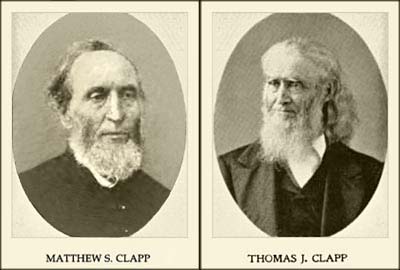
|
Matthew's 1831 letter
| Henry H.'s 1879 letter
Thomas' 1879 statement
|
Thomas' 1884 recollection
(under construction)
Notes: (forthcoming)
When Did SIDNEY RIGDON
First Meet JOSEPH SMITH?
Statements of
Zebulon Rudolph
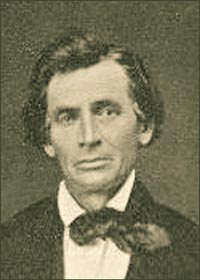
|
Zeb and John Rudolph (1884)
|
Zeb Rudolph (1885)
(under construction)
Notes: (forthcoming)
When Did SIDNEY RIGDON
First Meet JOSEPH SMITH?
Statements of
James A. Garfield
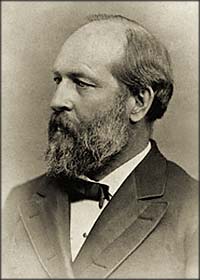
|
James Garfield (1880)
|
James Garfield (1880)
|
James Garfield (1880)
(under construction)
Notes: (forthcoming)
|





